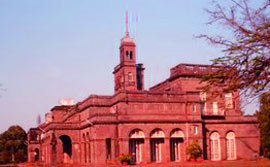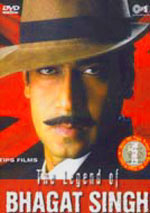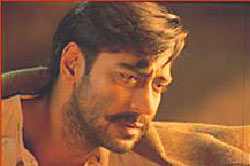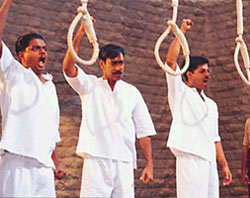|
Travelogues Legend of a Bollywood Extra
|
|||||
'Hey, wanna be an extra in a Bollywood movie?'
I have just stepped out of a dingy Mumbai cafe where I've spent two hours surfing the net, unsuccessfully looking for a way to become an extra in a Bollywood movie.
'Maybe,' I say squinting into Colaba's noon sun, only partially overcoming my habit of saying no to touts. We pull into a doorway out of the flow of people. He leans in towards me so I can hear him above the street noise.
'Music video for movie. Tonight.'
The guy's older and better dressed than the kids who work for the hotels. Unaccustomed to being offered something I actually want, I resist. A show-tune suddenly blasts out from his chest. He digs into his jacket, pulls out a mobile phone, offhandedly shoves a business card into my hand and ignores me as he shouts machine gun Hindi into his phone while gesturing at the traffic. Now I want to get his attention.
|
More on Maharashtra • Forts of Maharashtra
Travelogues
Impressions
Faces of India | ||||
'Yeah, I can make it tonight' I say when he finally rings off. 'What do I need to do - wear anything special?'
'No, we have a wardrobe. Just make sure you come at 7 pm. Meet at the Leopold Café.' 'So I passed the audition? I'll have to run it by my agent. 'For me it's a game, for him it's a job, so he ignores me again, and by way of revenge plays his own game, pulling me into the flow of people and jagging across the street between a jam of lumbering old Ambassador Taxis and whining black and yellow auto-rickshaws. 'There' he says as we turn the corner, pointing out the Leopold. 'Tonight.'
At ten past seven I find a group of people waiting outside the Leopold Café with the tout. We pile into a few taxis and battle down the street for a couple of kilometres in a manic combination of acceleration and braking before turning into an abandoned lot of derelict factories and warehouses. The crew is concentrated around the entrance of a huge shelled-out building with broken windows. We're taken down a side alley where an old toilet block and storage room are being used as a wardrobe and changing rooms. There are eight extras, all travellers in our twenties. The tout disappears and we begin what becomes the routine of being ignored and speculating on what is happening while waiting for someone to tell us what to do. Guys walk around talking into walkie-talkies. Six beautiful Indian women in full makeup burst out of the wardrobe room and totter down the potted alley towards the crew. Two hours later we discover our part is to make up the audience of a nightclub where the hero sings, backed by the dancers. Our wardrobe options are made up exclusively of Hawaiian shirts and neon coloured trousers. That's all there is - believe me, I looked through them all. Then we're told the shoot is just a music video, not part of a movie, that we're required until six in the morning, we'll be paid 800 rupees, $15 USD, and that there are too many of us. Three people will not be needed, but we're welcome to stay and watch the shooting. I offer the others my part, but that small act of selflessness was my acting for the night - I was grateful for any excuse not to have to wear those clothes. I stay for an hour, hovering behind the director watching the playback screen. The singer is handsome and charismatic despite being reminiscent of a combination of Enrique Iglesias and John Travolta, complete with Enrique's pseudo-suave facial expressions and John's Saturday Night Fever dance moves, all without a trace of irony. The dancers are mesmerising, but after an hour I leave with the two Scandinavian girls who also volunteered to miss out. We walk off the set to the visible envy of those who stay. I didn't get my fifteen seconds of fame, but I did get a lead from one of the producers I'd talked to while watching the shoot from behind the camera. Her husband, also a producer, is looking for extras who can commit to at least one weeks work on a movie.
Before dawn, after less than twenty four hours chasing the celluloid dream in Mumbai, I'm on a train back to where I came from, back to Pune, but this time with a scrawled phone number in my back pocket and a lead from a Bollywood producer.
Despite being a policeman on the trail of an outlaw, and even more remarkably, despite the white hat, it becomes clear that I'm one of the bad guys. The injustice and brutality of colonial rule was also a theme in Lagaan, one of a growing band of Bollywood movies to be successfully exported to an audience beyond the substantial foreign market of non-resident Indians. Lagaan's set-pieces, in which people bravely rebel against immensely cruel and unfair treatment from the British, were greeted with loud applause and shouting during the typically interactive screening I had seen a few days earlier.
The first few days involve various shots where the ten western extras ride around a courtyard while Devgan shoots a policeman, actually a teacher from South Africa. I pass by on a horse and carriage, which rears up and falls in my first ever take, then in the back of a beautiful vintage convertible limousine driven by its seventy year old owner. We work twelve hour days mid-thirty degree temperatures in heavy costumes. Throughout it all, Devgan maintains supernaturally studied cool, supported by a constant chain of Marlboro Lights. Crowds constantly watch from a distance of about fifty metres. One afternoon a couple of young female students make it past the real police onto the set. They are forcibly stopped before they get to Devgan, but seeing the commotion, he insists they be allowed to come, weak-kneed, towards him, and receive signatures. An hour later, a few hundred people break the line and stampede towards us. Their excitement turns into the manic exhilaration of a riot with a growing undercurrent of violence. I step forward to block the entrance to our extras enclave in a bluff of police authority, but the real police have to draw their long sticks to force the crowd back. The crowds enthusiasm is in no way dampened, in fact it grows. In the evening, as we try to leave, our bus is mobbed. The glamour and excitement of the star, by mere proximity, had rubbed off on to us. Our way is completely blocked by the sea of people. The other extras are cursing them as some force picks me up and walks me down the aisle of the bus. I open the door and practically stage-dive into the crowd of a couple of hundred people, my arms raised in exaggerated triumph, cheering them, and receiving a mass cheer in response. Paper and pens are pushed towards me. I'm jostled, but manage to sign autographs and pose for photographs. Children are hoisted up and offered to me - I raise them above my head to more cheers. I slowly move the crowd away from the bus before turning, slicing through the mass and diving back into the bus doors. I flash victory and namaste signs, waving goodbye as the now sated crowd cheers and allows us to pull away. I walk back down the aisle to stunned silence, my eyes down, but with a deep smile on my face.
Months later, back in Sydney, I catch the tail-end of a review of The Legend of Bhagat Singh on SBS TV, and track down a copy of the DVD in an Indian food and video store in Newtown. After an hour's viewing, I find my scenes and do a frame by frame advance through my fifteen seconds of fame. Unfortunately, this method clearly reveals that each time I fire a round in my heroic shoot-out scene, my eyes clamp shut. The movie was one of three releases about Bhagat Singh that year. It performed well at the box office and was widely critically acclaimed, confirming the legend of the star, the director, and one unnamed extra.
|
|||||
Editor: Romola Butalia (c) India Travelogue. All rights reserved. |
|||||
 I have come to Mumbai from Pune to follow my modest dream of making it into the movies. I had been enjoying the hospitality of a local, a fellow paraglider I met while flying in the foothills of the Himalaya. An evening at a thronging smoky theatre watching Lagaan reminded me of the possibility of Europeans getting roles in the movies. Two days later I was sitting in an internet café in Mumbai thinking I'd never find a way into the movies. Then I stepped out onto the street.
I have come to Mumbai from Pune to follow my modest dream of making it into the movies. I had been enjoying the hospitality of a local, a fellow paraglider I met while flying in the foothills of the Himalaya. An evening at a thronging smoky theatre watching Lagaan reminded me of the possibility of Europeans getting roles in the movies. Two days later I was sitting in an internet café in Mumbai thinking I'd never find a way into the movies. Then I stepped out onto the street.

 There is just one catch. The movie is being shot in Pune starting the next morning.
There is just one catch. The movie is being shot in Pune starting the next morning.
 The film, The Legend of Bhagat Singh, tells the story of a Sikh freedom fighter in the 1920's who became frustrated by Gandhi's doctrine of non-violent resistance, let off a bomb in parliament, was caught and eventually hanged at the age of twenty-three. Pune's preserved old-world charm made its parks and buildings better locations for shooting a period drama than Mumbai. Pune University is converted into a pre-Pakistan Lahore, and I'm converted into a pre-hippy colonial policeman. My hair is duly cut, I am expertly shaved, fitted with a false moustache, given a white uniform with a thick black belt on the outside of the jacket topped by white tropical hard hat.
The film, The Legend of Bhagat Singh, tells the story of a Sikh freedom fighter in the 1920's who became frustrated by Gandhi's doctrine of non-violent resistance, let off a bomb in parliament, was caught and eventually hanged at the age of twenty-three. Pune's preserved old-world charm made its parks and buildings better locations for shooting a period drama than Mumbai. Pune University is converted into a pre-Pakistan Lahore, and I'm converted into a pre-hippy colonial policeman. My hair is duly cut, I am expertly shaved, fitted with a false moustache, given a white uniform with a thick black belt on the outside of the jacket topped by white tropical hard hat.
 In the movie I'm a bad guy, but on the set I'm just part of the carnival. Every morning our small bus has to plough through a large crowd before we get to the make-up tent. Cordons are manned by police to keep thousands of people away from a large courtyard where we spend a few days shooting. The star, Ajay Devgan, is greeted by deafening screams anytime he comes into view.
In the movie I'm a bad guy, but on the set I'm just part of the carnival. Every morning our small bus has to plough through a large crowd before we get to the make-up tent. Cordons are manned by police to keep thousands of people away from a large courtyard where we spend a few days shooting. The star, Ajay Devgan, is greeted by deafening screams anytime he comes into view.
 The last few days are the best, from an "acting" point of view. I get some full screen shots in a pistol shoot-out. The director tells me to run, take a position shielded against a tree and fire a few rounds. The camera will follow me from behind, then sweep around to catch me firing. On the first take I run and hit the tree hard with my shoulder - it tilts, and nearly falls over. I hadn't noticed it was a prop, a fake plastic tree. The guns fire blanks that create a deafening bang, a firework flash of red and white light, and a lot of smoke - but after six hours waiting on that day alone I'm glad to be in the action. Just as I'm getting the hang of it and starting to enjoy myself after a long, tiring and often boring week, the director yells 'cut, good, done', and it's over.
The last few days are the best, from an "acting" point of view. I get some full screen shots in a pistol shoot-out. The director tells me to run, take a position shielded against a tree and fire a few rounds. The camera will follow me from behind, then sweep around to catch me firing. On the first take I run and hit the tree hard with my shoulder - it tilts, and nearly falls over. I hadn't noticed it was a prop, a fake plastic tree. The guns fire blanks that create a deafening bang, a firework flash of red and white light, and a lot of smoke - but after six hours waiting on that day alone I'm glad to be in the action. Just as I'm getting the hang of it and starting to enjoy myself after a long, tiring and often boring week, the director yells 'cut, good, done', and it's over.